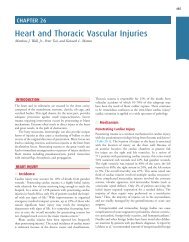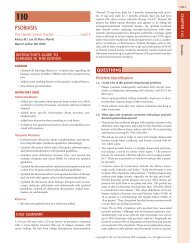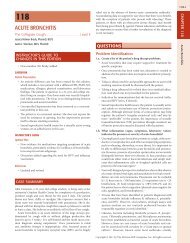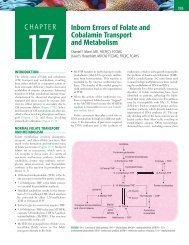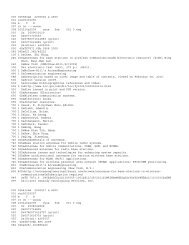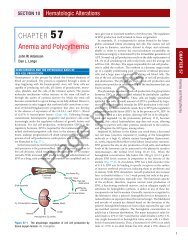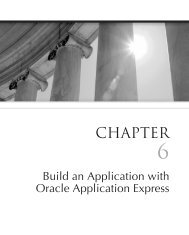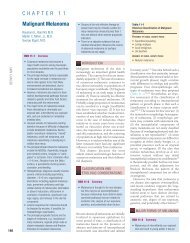Seizures and Epilepsy
Seizures and Epilepsy
Seizures and Epilepsy
You also want an ePaper? Increase the reach of your titles
YUMPU automatically turns print PDFs into web optimized ePapers that Google loves.
34 ■ Section 2: Common Pediatric Neurologic Problems<br />
Table 3-6.<br />
Frequency of Aura Types by Location<br />
Temporal Frontal Occipital<br />
Aura Type (%) (%) (%)<br />
Auditory 10 0 0<br />
Cephalic 5 15 5<br />
Epigastric 50 15 5<br />
General 10 15 5<br />
Gustatory 10 0 10<br />
None 15 40 5<br />
Olfactory 10 0 10<br />
Psychical 15 5 15<br />
Somatosensory 5 15 0<br />
Visual 10 5 50<br />
Vertiginous 10 2 0<br />
Occipital lobe epilepsy. Occipital lobe epilepsy is rare,<br />
accounting for less than 10% of partial seizures. Prodromes<br />
are rare with occipital lobe seizures <strong>and</strong> auras<br />
are unusual. As with the frontal lobe seizures, the seizure<br />
characteristics are dependent on the area of the occipital<br />
lobe involved. When the striate cortex is involved,<br />
there are typically elemental visual hallucinations.<br />
Involvement of the lateral occipital lobe results in<br />
twinkling, pulsing lights. <strong>Seizures</strong> arising from the<br />
temporo-occipital are usually associated with formed<br />
visual hallucinations. 37-39<br />
Parietal lobe epilepsy. Parietal lobe seizures are also<br />
relatively uncommon. The may be seen as simple partial<br />
seizures but they will often propagate. The initial features<br />
can include contralateral paresthesias, contralateral<br />
pain, idiomotor apraxia, <strong>and</strong> limb movement sensations.<br />
As the seizure progresses <strong>and</strong> propagates, asymmetric<br />
tonic posturing <strong>and</strong> automatisms may develop. 40-42<br />
L<strong>and</strong>au–Kleffner syndrome. L<strong>and</strong>au–Kleffner syndrome<br />
is a rare, invariably progressive, idiopathic acquired aphasia<br />
related to a focal epileptic disturbance in the area of the<br />
brain responsible for verbal processing. 43 The syndrome<br />
begins between ages 3 <strong>and</strong> 10 in a child with normally<br />
acquired language abilities. The child then develops a<br />
verbal auditory agnosia <strong>and</strong> infrequent nocturnal partial<br />
or secondarily generalized seizures. The syndrome has a<br />
pathognomonic EEG pattern consisting of high-voltage<br />
multifocal spikes, predominating in the temporal lobes. 44<br />
Treatment is usually with valproic acid <strong>and</strong> benzodiazepines.<br />
45 Sometimes corticosteroids <strong>and</strong> IV Ig or even<br />
surgery with subpial transection 46 are used in refractory<br />
cases. The outcome for overall language <strong>and</strong> cognitive<br />
function depends in part on how early the syndrome is<br />
recognized <strong>and</strong> treated, but over 2/3 of children are left<br />
with significant language or behavioral deficits. 47<br />
Rasmussen encephalitis. Rasmussen encephalitis is a<br />
syndrome of diffuse lymphocytic infiltration of the brain<br />
associated with partial seizures <strong>and</strong> progressive neurological<br />
deterioration with hemiparesis. This disorder typically<br />
affects children 1 to 14 years old. The syndrome is associated<br />
with perivascular cuffing on pathologic sections, <strong>and</strong><br />
antibodies to the glutamate subunit GluR3 are commonly<br />
identified. The disorder is usually unilateral. Rasmussen<br />
encephalitis is very difficult to treat <strong>and</strong> frequently<br />
requires surgical management with hemispherectomy.<br />
EVALUATION<br />
As with many facets of neurology, the history is the<br />
most important diagnostic tool <strong>and</strong> should include<br />
information on each of the items in Table 3-7. The<br />
history should be obtained from family <strong>and</strong> eyewitnesses,<br />
if possible. Many patients are unable to provide<br />
accurate descriptions of the seizure <strong>and</strong> the postictal<br />
period.<br />
MRI of the head with temporal lobe protocol (thin<br />
coronal slices through hippocampi) is the preferred imaging<br />
modality for most patients. The MRI sequences are<br />
much more sensitive to the causes of epilepsy than is CT<br />
imaging. CT can, however, be of help in the emergency<br />
department setting. EEG is a vital component of the evaluation<br />
to categorize the seizure type <strong>and</strong> assist with planning<br />
of the treatment strategy. The need for laboratory<br />
testing is highly variable depending on the history. Initial<br />
evaluation with fluid balance profile (FBP), Ca++,<br />
Aura Types<br />
Table 3-7.<br />
Psychical Auras Illusion Hallucination<br />
Memory Déjà vu, jamais Flashbacks<br />
vu, strangeness<br />
Sound Advancing, receding, Voices, music<br />
louder, softer, clearer<br />
Self-image Depersonalization, Autoscopy<br />
remoteness<br />
Time St<strong>and</strong>-still, rushing,<br />
slowing<br />
Vision Macropsia, micropsia, Objects, faces,<br />
near, far, blurred scenes



